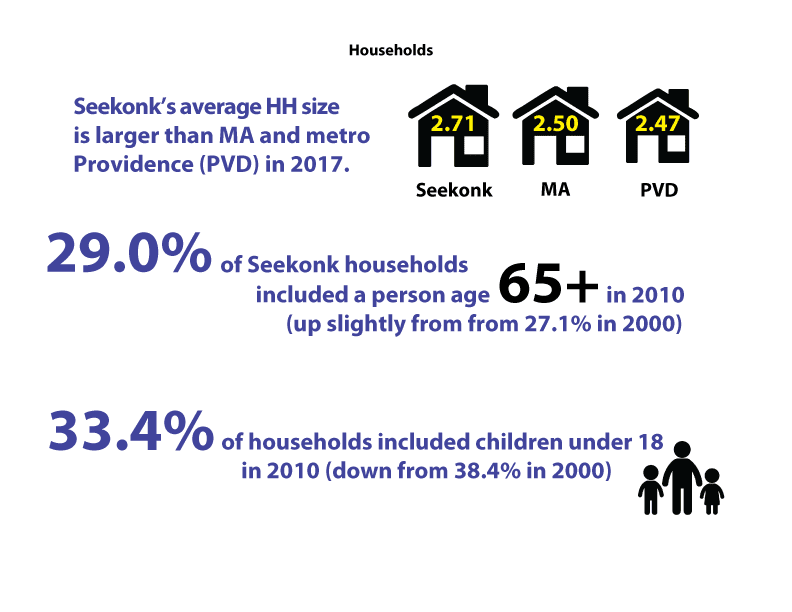Age
Relative to the Metro Providence region and to MA, as a whole, Seekonk has an older population. Much like the rest of the state and nation, Seekonk's population is aging - its median age has increased by over ten years since 1990.
Discussion Question: Has the "needed service" profile changed along with the Town's aging population?
Sources: ESRI, U.S. Census Bureau
Households
In 2017, Seekonk's average HH size was 2.71; this was larger than that of MA, at 2.50, and Metro Providence, at 2.47. Over the next 5 years, the town, Metro Providence, and MA are all projected to maintain approximately the same average HH size.
Sources: U.S. Census Bureau, SRPEDD

Income
Relative to the Metro Providence region and to the Commonwealth, Seekonk is an affluent community; however, its incomes are projected to grow at slightly slower rates than in the region and state.
Discussion Question: Does Seekonk see itself as a "bedroom community" of professionals working in Providence? (Note: According to the 2016 American Community Survey, 51.2% of workers [16 years-old and older] work outside of MA, presumable in Providence and RI, and only approximately 21.4% work in Seekonk, itself.) If so, how does this image inform its local policies?
Sources: ESRI, U.S. Census Bureau, SRPEDD
Education
Seekonk has a higher share of residents with "Higher Levels" of education than Metro Providence, but a lower share than the state.
Sources: ESRI, U.S. Census Bureau, SRPEDD
Unemployment
Seekonk has a lower Unemployment Rate than both Metro Providence and MA. Please see the chart and supporting table, below.
Source: ESRI
Tax Rate
The split between Seekonk's Residential millage rate and Commercial millage rate is large compared to nearby communities and the SRPEDD Region.
Discussion Question: How are tax rates and tax policy perceived by Seekonk's residents and businesses?
Sources: Massachusetts Division of Local Services (DLS), SRPEDD
Tax Levy
Thanks to its relatively high split commercial rate, Seekonk has a fairly diversified tax base compared to nearby comminutes.
Discussion Question: What's your take on the Town's recent history of fiscal health and policy?
Sources: Massachusetts Division of Local Services (DLS), SRPEDD
Industry Location Quotient (LQ) Analysis
Location Quotient (LQ) Analysis is a way to understand how Seekonk's employment patterns compare to those of a larger region - in this case both Metro Providence (first table) and the state of MA (second table). LQ is basically a ratio, where, if an industry's LQ is greater than one (>1), Seekonk has a higher share of jobs in that industry than its surrounding region. For example, in the table from 2017, below, Seekonk's LQ with Metro Providence in "Retail Trade" is 2.4 (or 32.4% divided by 13.3%). This indicates that Retail as an industry is roughly two-and-a-half times more concentrated in Seekonk than it is in the surrounding region. This finding, along with Accomodation and Food Services at an LQ of 2.1, corresponds with the predominance of retail and dining establishments the town's list of the town's top employers from the MA Executive Office of Labor and Workforce Development (EOLWD).
LQ can provide even more insight into a local economy when combined with trends. For more on this, please the second LQ table, below.
Discussion Question: What does Seekonk's high share of Retail Trade and Accomodation and Food Services tell us about the Town's economic base? What policy tools are available to minimize fluctuations in these sectors?
Sources: ESRI, SRPEDD
LQ Table 1: 2017 Snapshot, Seekonk Compared to Metro Providence
Industries with high LQs are typically "export" industries, meaning that they bring economic activity into town (instead of simply circulating money and resources that are already in town, as is typically the case with Retail and Service industries, except where otherwise indicated in Retail Market Analysis [see below]). From this perspective, the town's most important industries are those with both high LQs, indicating they are highly concentrated, and those with a high share of the town's overall employment. Policy makers should monitor trends in both overall employment and LQ in these industries. For example, in Seekonk from 2001 - 2016, the Construction, Retail Trade, Transportation and Warehousing, and Accommodation and Food Services industries were all fairly sizable (in terms of their share of total employment in Seekonk), relatively concentrated (LQs >1), and growing (in terms of both their share of overall employment in town and in LQ [with the exception of Accommodation and Food Services, which grew, but did so at much slower rate than in MA, resulting in a reduction of its LQ over the period]). Industries with negative trends from 2001 to 2016 include Other Services (which is relatively concentrated, but lost both overall share and LQ) and Education Services (which, while not relatively concentrated, has a fairly high share of overall employment and experienced job losses while MA experienced growth).
Sources: ESRI, SRPEDD
LQ Table 2: 2001 - 2016 Trends, Seekonk Compared to MA